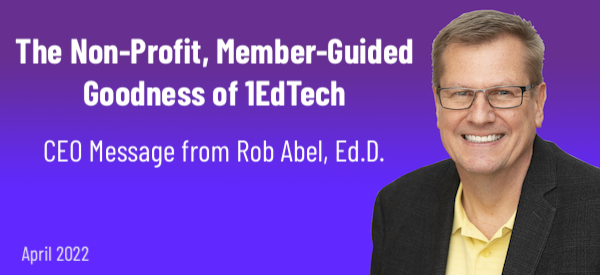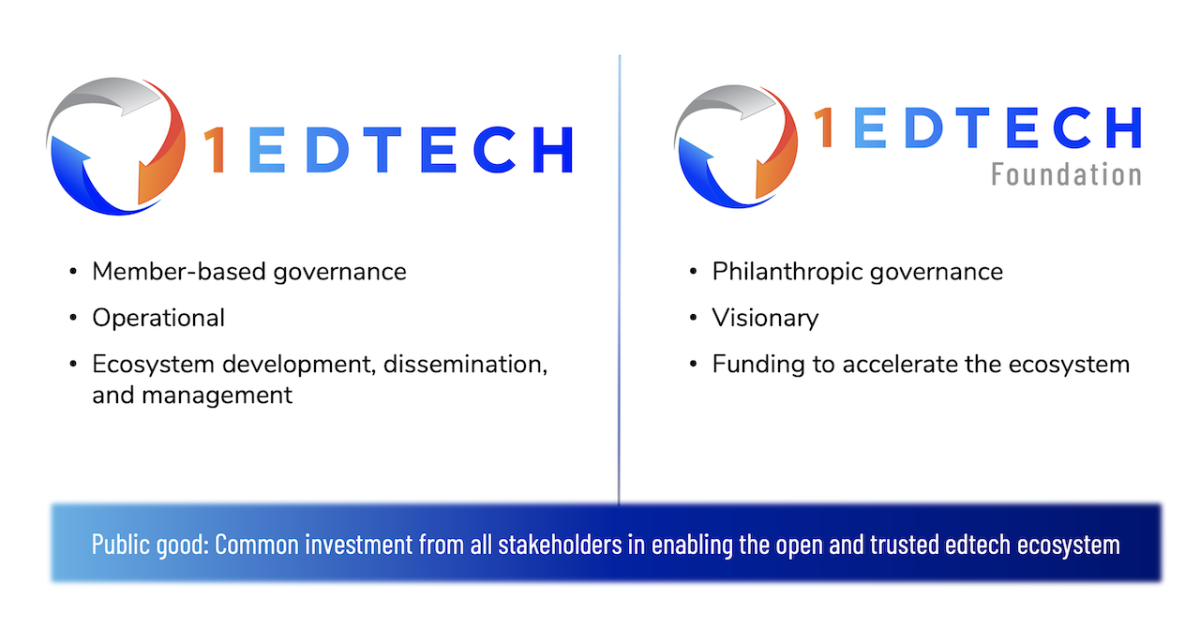
As we close in on the official transition from IMS Global Consortium to 1EdTech, I wanted to add to my previous posts about the 1EdTech brand to explain the value of having two affiliated organizations under the 1EdTech brand: the 1EdTech Foundation and the 1EdTech Consortium.

The Role of 1EdTech in Public and Private Benefit
The 1EdTech brand promise is to power learner potential through a united community dedicated to an open and trusted educational technology ecosystem that makes life better for all stakeholders. Yes, it’s a bold statement, but one made with humility given the 25-year history of enduring impact we have already made, with much more to come.
My friend, colleague, and mentor of many years, Dr. Bill Graves, would often talk about how education is both a “public and private good.” This simple phrase has deep meaning. It is a source of pride for those in our community who have given themselves to the world of education. It means that in education, there is both public benefit (the positive impacts on society) and private benefit (the positive impacts on the individuals). You don’t need to think too long to realize they are both needed in our world. The phrase also means that we recognize that there is a compact with society to serve more than private gains.
The reality of public and private benefit is reflected daily in the work of the 1EdTech Consortium.
Publicly owned organizations work shoulder to shoulder with privately-owned organizations as equal partners. They are all held to the same high standard of enabling the foundation for an open and trusted ecosystem. Most importantly, this high bar is reinforced with a Board of Directors that cut across the various types of organizations and is charged with taking responsibility for achieving the community goals, including overseeing the community-based consensus-driven approach that has been a key to the success of organizations like ours.
The Non-Profit Status of 1EdTech and 1EdTech Consortium
There are many types of non-profit organizations and many ways that for-profit organizations can be related to non-profits. Different kinds of non-profits can be associated with each other. In the world of standards and edtech associations, there are different types of non-profits and even for-profit organizations. I will explain here the reasons that 1EdTech Consortium will continue to be organized as 1EdTech was, as a 501c6 non-profit.
A 501c6 is generally characterized as an “industry league” or “chamber of commerce.” It is exempt from taxes but not a charity (a contribution is not considered deductible as a charitable donation by the IRS). The other potential non-profit designation in the 1EdTech/1EdTech by-laws is a 501c3. A 501c3 organization is a charity. 1EdTech Consortium/1EdTech Consortium is clearly operating for the public good and would pass any IRS test in that regard, and that is why it could operate as a 501c3. For clarity and transparency, we feel that the 501c6 designation is a better fit for a membership organization in which the members have voting rights, and a majority of the Board of Directors comes from the members.
The Value of Adding a Non-Profit Charity as an Affiliated Organization
I spent many hours discussing how to best manifest the ideas of public and private good into the business structure of 1EdTech. This led to the (relatively quiet) formation several years ago (but, unfortunately, after Bill’s passing) of the 1EdTech Foundation, a public charity dedicated to supporting the mission of 1EdTech (this type of relationship is supported by what the IRS refers to as a “Type I” supporting organization). It’s a very simple idea to create a public charity that utilizes philanthropic funding to advance work that can accelerate the open and trusted edtech ecosystem that is managed more directly through our organizational operations.
The 1EdTech Foundation has already attracted some very generous funding from various sources but has really just begun. Moving IMS Global Consortium to the same brand of 1EdTech (technically the 1EdTech Consortium) makes the connection clearer.
You might wonder why this is necessary, as many know that IMS has received grants from some of the major foundations in the past? The short answer is that many philanthropic sources prefer giving to 501c3s. The longer answer is that separating the operational aspects of the mission and the policy aspects of the mission can be a good thing, which is why we envisioned this setup.
In my next post of the series, I will discuss some specifics of our philanthropic work.



